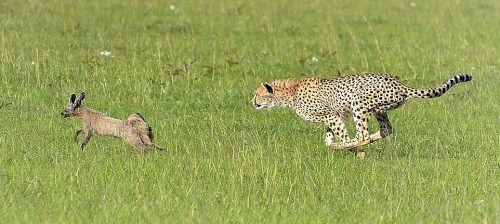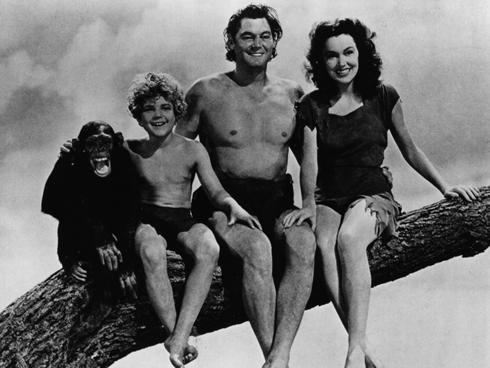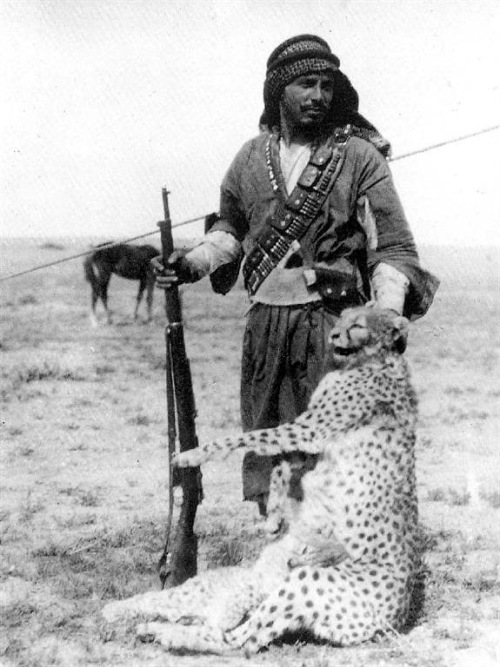
We think of interactions between predators as always antagonistic. Meat is hard to come by, and if one comes by meat on the hoof, it is unlikely that the owner-operator of said flesh will give it up willingly. Meat is a prized food source, and it is little wonder that most predators spend quite a bit of energy driving out competitors from hunting grounds.
Because of this antagonism, the domestication of wolves by ancient hunter-gatherers is difficult to explain. Indeed, the general way of getting wolves associated with people is see them as scavengers that gradually evolved to fear our species less.
This idea is pretty heavily promoted in the dog domestication literature, for it is difficult for experts to see how wolves could have been brought into the human fold any other way.
But there are still writers out there who posit a somewhat different course for dog domestication. Their main contentions are that scavengers don’t typically endear themselves to those from which they are robbing, and further, the hunter-gatherers of the Pleistocene did not produce enough waste to maintain a scavenging population of wolves.
It is virtually impossible to recreate the conditions in which some wolves hooked up with people. With the exception of those living on the some the Queen Elizabeth Islands, every extant wolf population has been persecuted heavily by man. Wolves generally avoid people, and there has been a selection pressure through our centuries of heavy hunting for wolves to have extreme fear and reactivity. It is unlikely that the wolves that were first encountered on the Mammoth Steppe were shy and retiring creatures. They would have been like the unpersecuted wolves of Ellesmere, often approaching humans with bold curiosity.
As I have noted in an earlier post, those Ellesmere wolves are an important population that have important clues to how dog domestication might have happened, but the truth of the matter is that no analogous population of wolves or other wild canids exists in which cooperation with humans is a major part of the survival strategy. The wolves on Ellesmere are not fed by anyone, but they don’t rely upon people for anything.
But they are still curious about our species, and their behavior is so tantalizing. Yet it is missing that cooperative analogy that might help us understand more.
I’ve searched the literature for this analogy. I’ve come up short every time. The much-celebrated cooperation between American badgers and coyotes is still quite controversial, and most experts now don’t believe the two species cooperate. Instead, they think the badger goes digging for ground squirrels, and the coyote stand outside the burrow entrance waiting for the prey to bolt out as the badger’s digging approaches its innermost hiding place in the den. The coyote gets the squirrel, and the badger wastes energy on its digging.
But there is a story that is hard to dispute. It has only been recorded once, but it is so tantalizing that I cannot ignore it.
Randall Eaton observed some rather unusual behavior between black-backed jackals and cheetahs in Nairobi National Park in 1966.
Both of these species do engage in cooperative hunting behavior. Black-backed jackals often work together to hunt gazelles and other small antelope, and they are well-known to work together to kill Cape fur seal pups on Namibia’s Skeleton Coast. Male cheetahs form coalitions that work together to defend territory and to hunt cooperatively.
However, the two species generally have a hostile relationship. Cheetahs do occasionally prey upon black-backed jackals, and black-backed jackals will often mob a cheetah after it has made a kill, in hopes of forcing the cat to abandon all that meat.
So these animals usually cannot stand each other, and their interactions are not roseate in the least. Eaton described the “normal interaction” as follows:
The normal interaction between these two predators occurs when the jackals hunt in the late afternoon and come into a group of cheetahs. The jackals, often four or five, are normally spread out over several hundred yards and maintain contact by barking as they move. When cheetahs are encountered by one of the jackals, it barks to the others and they all come to the cheetahs, sniffing the air as they approach apparently looking for a kill. If the cheetahs are not on a kill, the jackals search the immediate area looking for a carcass that might have just been left by the cheetahs. If nothing is found, they remain near the cheetahs for some time, following them as they move ; and when a kill is made the jackals feed on the leftover carcass. If the cheetahs have already fed and are inactive and if a carcass is not found nearby, the jackals move on.
However, Eaton discovered that one particular group of jackals and one female cheetah had developed a different strategy:
At the time I was there in November, 1966, one area of the park was often frequented by a female cheetah with four cubs and was also the territory of a pair of jackals with three pups. The jackal young remained at the den while the adults hunted either singly or together. Upon encountering the cheetah family, the jackals approached to about 20 yards and barked but were ignored except for an occasional chase by the cubs. The jackals ran back and forth barking between the cheetahs and a herd of Grant’s gazelles (Gazella granti) feeding nearby. The two jackals had gone on to hunt and were almost out of sight by the time the adult cheetah attacked two male Grant’s gazelles that had grazed away from the herd. The hunt was not successful. The jackals took notice of the chase and returned to look for a kill ; it appeared that they associated food with the presence of the cheetahs and perhaps with the chase.
One month later, while observing the same cheetah family, I noticed that the entire jackal family was hunting as a group. The cheetah and her cubs were about 300 yards from a herd of mixed species. This same herd had earlier spotted the cheetahs and given alarm calls. The adult cheetah was too far away for an attack,there was little or no stalking cover and the herd was aware of her presence. The cheetahs had been lying in the shade for about one-half an hour since the herd spotted them when the jackals arrived. Upon discovering the cheetahs lying under an Acacia tree, one of the adult jackals barked until the others were congregated around the cheetah family. The jackal that had found the cheetahs crawled to within ten feet of the adult cheetah which did not respond. The jackal then stood up and made a very pneumatic sound by forcing air out of the lungs in short staccato bursts. This same jackal turned towards the game herd, ran to it and, upon reaching it, ran back and forth barking. The individuals of the herd watched the jackal intently. The cheetah sat up and watched the herd as soon as it became preoccupied with the activity of the jackal. Then the cheetah quickly got up and ran at half-speed toward the herd, getting to within 100 yards before being seen by the herd. The prey animals then took flight while the cheetah pursued an impala at full speed.
Upon catching the impala and making the kill, the cheetah called to its cubs to come and eat. After the cheetahs had eaten their fill and moved away from the carcass, the waiting jackals then fed on the remains.
Eaton made several observations of this jackal family working with this female cheetah, and by his calculations, the cheetah was twice as successful when the jackals harassed the herds to aid her stalk.
Eaton made note of this behavior and speculated that this sort of cooperative hunting could have been what facilitated dog domestication:
If cheetah and jackal can learn to hunt mutually then it is to be expected that man’s presence for hundreds, of thousands of years in areas with scavenging canines would have led to cooperative hunting between the two. In fact, it is hard to believe otherwise. It is equally possible that it was man who scavenged the canid and thereby established a symbiosis. Perhaps this symbiosis facilitated the learning of effective social hunting by hominids. Selection may have favored just such an inter-specific cooperation.
Agriculture probably ended the importance of hunting as the binding force between man and dog and sponsored the more intensive artificial selection of breeds for various uses. It is possible that until this period men lived closely with canids that in fossil form are indistinguishable from wild stock (Zeuner, 1954).
Domestication may have occurred through both hunting symbiosis and agricultural life; however, a hunting relationship probably led to the first domestication. Fossil evidence may eventually reconstruct behavioral associations between early man and canids.
Wolves are much more social and much more skilled as cooperative hunters than black-backed jackals are. Humans have a complex language and a culture through which techniques and technology can be passed from generation to generation.
So it is possible that a hunting relationship between man and wolf in the Paleolithic could have been maintained over many generations.
The cheetah had no way of teaching her cubs to let the jackals aid their stalks, and one family of jackals is just not enough to create a population of cheetah assistants.
But humans and these unpersecuted Eurasian wolves of the Pleistocene certainly could create these conditions.
I imagine that the earliest wolf-assisted hunts went much like these jackal-cheetah hunts. Wolves are always testing prey to assess weakness. If a large deer species or wild horse is not weak, it will stand and confront the wolves, and in doing so, it would be exposing itself to a spear being thrown in its direction.
If you’ve ever tried a low-carbohydrate diet, you will know that your body will crave fat. Our brains require quite a bit of caloric intake from fat to keep us going, which is one of those very real costs of having such a large brain. Killing ungulates that stood to fight off wolves meant that would target healthy animals in the herds, and healthy animals have more fat for our big brains.
Thus, working together with wolves would give those humans an advantage, and the wolves would be able to get meat with less effort.
So maybe working together with these Ellesmere-like wolves that lived in Eurasia during the Paleolithic made us both more effective predators, and unlike with the cheetah and the black-backed jackals, human intelligence, language, and cultural transmission allowed this cooperation to go on over generations.
Eaton may have stumbled onto the secret of dog domestication. It takes more than the odd population of scavenging canids to lay the foundations for this unusual domestication. Human agency and foresight joined with the simple cooperative nature of the beasts to make it happen.









